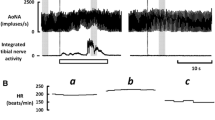Summary
In healty, conscious dogs the heart rate was kept constant at 144 to 146 beats per minute either by vagal blockade with Atropine (0,5 mg/kg i.v.) or by electrical pacing of the heart. In the resting dog a carotid-sinus-reflex was elicited clamping both common carotid arteries with implanted pneumatic cuffs. Velocity in the ascending aorta (electromagnetic flowmeter), pressure in the descending thoracic aorta (implanted miniature pressure transducer) and pressure in the right carotid sinus using a catheter were measured. By analogue processing acceleration in the ascending aorta, stroke volume and stroke work of the left ventricle, and mean values were derived. Compared to the reflex under normal resting heart rates (64 beats per minute) the results show, that with a constant heart rate (144–146 beats per minute) blood pressure rises by about the same amount induced by a larger increase of the peripheral resistance. Because the fast increase of cardiac output regularly observed under normal conditions was eliminated, the time course of pressure elevation was slower when heart rate was kept constant. The elevated stroke work of the left ventricle during carotid occlusion cannot be explained by an increase of contractility due to enhanced sympathetic activity, because no such increase in contractility was found.
It is suggested, that a low control heart rate allows fast reflex adjustment of blood pressure mediated by increases of cardiac output due to vagal inhibition. In contrast, when heart rate is high due to vagal blockade or electrical pacing, the reflex response is determined by slow changes of the total peripheral resistance.
Similar content being viewed by others
Literatur
Bishop, V. S., Horwitz, L. D.: Effects of altered autonomic control on left ventricular function in conscious dogs. Amer. J. Physiol.221, 1278 (1971).
Bond, R. F., Green, H. D.: Cardiac output redistribution during bilateral common carotid occlusion. Amer. J. Physiol.216, 393 (1969).
Browse, N. L., Donald, D. E., Shepherd, J. T.: Role of the veins in the carotid sinus reflex. Amer. J. Physiol.210, 1424 (1966).
Coleridge, J. C. G., Hemingway, A.: Partition of the venous return to the heart. J. Physiol. (Lond.)142, 56 (1952).
Corcondilas, A., Donald, D. E., Shepherd, J. T.: Assessment of two independent methods of the role of the cardiac output in the pressor response to carotid occlusion. J. Physiol. (Lond.)170, 250 (1964).
Donald, D. E., Samueloff, S. L., Ferguson, D.: Mechanism of tachycardia caused by atropine in conscious dogs. Amer. J. Physiol.212, 901 (1967).
Gessner, U., Bergel, D. H.: Frequency response of electromagnetic flowmeters. J. appl. Physiol.19, 1209 (1964).
Kirchheim, H., Gross, R.: Das Verhalten der Nierendurchblutung und des Nierenumfanges bei Blutdrucksteigerungen nach doppelseitigem Carotisverschluß oder Schrittmachertachykardie. Untersuchungen zur Autoregulation der Nierendurchblutung am wachen Hund. Pflügers Arch.329, 79 (1970).
Kirchheim, H., Gross, R.: Hemodynamics of the carotid sinus reflex elicited by bilateral carotid occlusion in the conscious dog. Effect of α- or β-adrenergic blockade on the reflex response. Pflügers Arch.327, 203 (1971).
Krayer, O., Benforado, S. M.: Die Schlagfrequenz des akut denervierten Herzens im Herz-Lungen-Präparat des Hundes mit einem Hinweis auf die frequenzbeschleunigende Wirkung des Adrenalins. Pflügers Arch. ges. Physiol.260, 177 (1955).
Lacroix, E., De Meester, G., Leusen, J.: Effects of beta-adrenergic blockade on the hemodynamic response to carotid sinus reflex. Arch. int. Pharmacodyn.175, 447 (1968).
Noble, M. I. M., Trenchard, D., Guz, A.: Left ventricular ejection in conscious dogs. I. Measurement and significance of the maximum acceleration of blood from the left ventricle. Circulat. Res.19, 139 (1966).
Noble, M. I. M., Trenchard, D., Guz, A.: Effect of changing heart rate on cardiovascular function in the conscious dog. Circulat. Res.19, 206 (1966).
Noble, M. I. M., Wyler, J., Milne, E. N. C., Trenchard, D., Guz, A.: Effect of changes in heart rate on left ventricular performance in conscious dogs. Circulat. Res.24, 285 (1969).
Rushmer, F. F.: Origins of pulsatile flow: In: Pulsatile blood flow, p. 221. New York: Mc Graw Hill 1964.
Rushmer, F. R.: Recent advances in cardiovascular physiology. Anesth. Analog. Curr. Res.45, 383 (1966).
Sarnoff, S. J., Gilmore, J. P., Brockman, S. K., Mitchell, J. H., Linden, R. J.: Regulation of ventricular contraction by the carotid sinus. Its effect on atrial and ventricular dynamics. Circulat. Res.8, 1123 (1960).
Sarnoff, S. J., Mitchell, J. H., Gilmore, J. P., Remensnyder, J. P.: Homeometric autoregulation in the heart. Circulat. Res.8, 1077 (1960).
Schmidt, H. D.: Die autonome Schrittmacherfrequenz des Hundeherzens. Pflügers Arch.308, 137 (1969).
Stone, H. L., Bishop, V. S.: Ventricular output in conscious dogs following acute vagal blockade. J. appl. Physiol.24, 782 (1968).
Stone, H. L., Bishop, V. S., Dong, E.: Ventricular function in cardiac-denervated and cardiac-sympathectomized conscious dogs. Circulat. Res.20, 782 (1967).
Whitty, A. J., Shephard, R. S.: Role of the vagus in control of the cardiac output in the anesthetized dog. Amer. J. Physiol.213, 1520 (1967).
Author information
Authors and Affiliations
Additional information
Mit dankenswerter Unterstützung der Deutschen Forschungsgemeinschaft (S.F.B. 90).
Rights and permissions
About this article
Cite this article
Gross, R., Kirchheim, H. Der Einfluß einer konstanten Herzfrequenz auf den Carotis-Sinus-Reflex am wachen Hund. Pflügers Arch. 337, 59–70 (1972). https://doi.org/10.1007/BF00587873
Received:
Issue Date:
DOI: https://doi.org/10.1007/BF00587873




